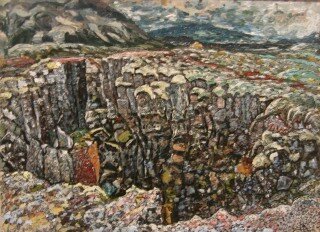On long, cold and dark winter nights didn´t people in the old times had much light but lot of dark. It had good times on the evening telling stories about ghosts, hidden people and other creatures
Ghosts are souls of dead people who died in anger, had secret or was hiding something like money.
The hidden people live in rock and hills, they look like humans in apperance and clothing but they have magic power. Sometimes the fell in love with humans and the usually go very bad
Exposed child, if woman was pregnant and wasn´t able to have the baby was it put on some clothing and carryed away to die.
Nykur is some kind of horse, they are usually black and their hoof turn backwards. The try to deceive people on back and then run to the lake with them on back.
One of Iceland most famous ghost stories.
Long time ago was young man who was deacon and lived in place called Dark-river and there was a church. He had a horse called Faxi and girlfriend named Guðrún who lived across the river. Two weeks before chirstmas was he going to invite her to a Christmas celebration. The weather was very bad when he was leaving and he went on his horse.When deacon was on the bridge was Faxi scared and the deacon felt in the river. A man from next farm found Faxi and he got worried because he saw the deacon leaving last night and the same day the deacon was found dead on ice in the river and was very indjured in the head and he was burryed in the week before christmas. Because the weather was so bad nobody across the river heard about his death. On chistmaseve Guðrún got dressed up for the celebration, then was knock on the door and the maid open it but she saw nobody but Faxi and said Guðrún that the deacon was there. Guðrún hurried up got her coat but was in one sleeve . On the way to Dark- rive they didn´t talk together but when his hat went off him. Then he said
The moon is shining
the death is riding
can't you see the with spot
on my head Garún Garún
(Because god is in the name Guðrún ,he couldn´t say her name)
Guðrún was shocked but she said nothing, and when arrived they went in the cemetery and there saw Guðrún open grave and deacon took her loose sleeve and Guðrún ran to the church and rang the bells. The deacon was coming to her the evening so she slept with light and someone was awake in her room while she was sleeping.
- Aðalbjörg
























































